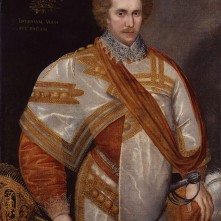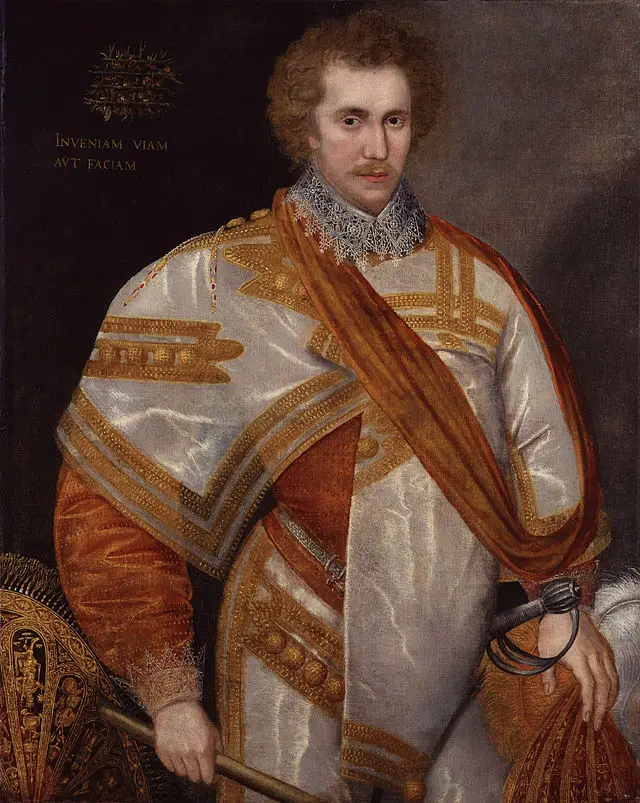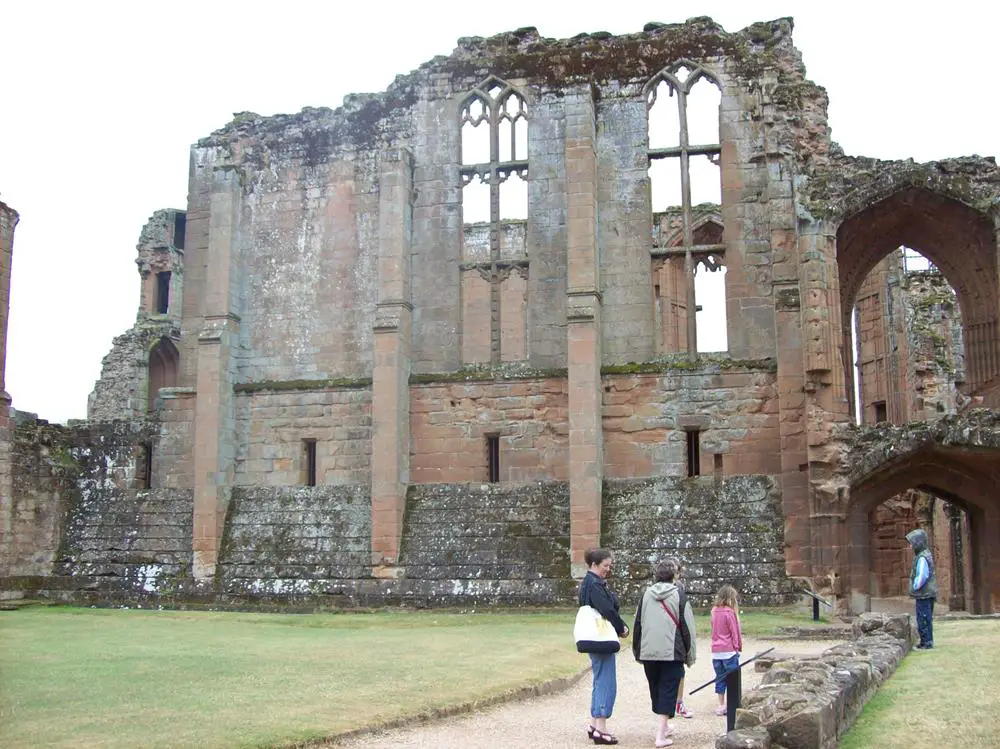13 July
1527 - Birth of John Dee, astrologer, mathematician, alchemist, antiquary, spy, philosopher, geographer and adviser to Elizabeth I and various influential statesmen during her reign, in London. Click here to read more about him.1551 – Death of Sir John Wallop, soldier and diplomat, at Guînes from sweating sickness. His body was buried at Guînes, but then moved to the parish church at Farleigh Wallop, his home town.
1566 – Death of Sir Thomas Hoby, diplomat, courtier and translator, at Paris. He was buried in Bisham parish church. His translations included “The Gratulation of M. Martin Bucer unto the Church of England” (1549) and Castiglione's “Il cortegiano” (1561).
1612 – Death of Edward Seymour, Viscount Beauchamp, eldest son of Edward Seymour, 1st Earl of Hertford, and Lady Katherine Grey, at Wick in Wiltshire. He was buried first at Bedwyn Magna and then in Salisbury Cathedral.
1626 – Death of Robert Sidney, 1st Earl of Leicester, poet and courtier, at Penshurst Place. He was buried at Penshurst on the 16th July. His notebook, which still survives today, holds a collection of poems and sonnets, and also shows the revisions he made to them.
14 July
1486 – Death of Margaret of Denmark, Queen of Scots and consort of James III, at Stirling Castle. She was buried in Cambuskenneth Abbey. False rumours spread that she had been murdered by poison by John Ramsay, 1st Lord Bothwell, but there was no evidence of this.1514 – Death of Cardinal Christopher Bainbridge, also Ambassador and Archbishop of York, in Rome. His death was controversial, in that his servant, Raimondo da Modena, confessed to poisoning him on the orders of Silvestro Gigli, Bishop of Worcester, and the English ambassador at Rome. He was buried in chapel of the English Hospice (now the English College) in Rome.
1544 – Henry VIII landed at Calais in preparation for the Siege of Boulogne, which began five days later.
1551 – Deaths of Henry Brandon and Charles Brandon, sons of the late Charles Brandon, Duke of Suffolk, and Catherine Brandon (née Willoughby), Duchess of Suffolk, from sweating sickness in Buckden, Huntingdonshire. They were buried at Buckden. Charles survived his brother by just half an hour.
1575 – Death of Richard Taverner, evangelical reformer and translator, at Woodeaton in Oxfordshire. Taverner is known for his Bible translation known as “Taverner's Bible”, or, to give it its full name, “The Most Sacred Bible whiche is the holy scripture, conteyning the old and new testament, translated into English, and newly recognized with great diligence after most faythful exemplars by Rychard Taverner”. He was buried in the parish church at Woodeaton.
1599 – Death of Sir Robert Salesbury, member of Parliament, Justice of the Peace and Deputy Lieutenant of Denbighshire.
1621 – Death of Edmund Hooper, composer and organist of Westminster Abbey and the Chapel Royal, in London. He was buried in the cloisters of Westminster Abbey.
15 July
1497 – Birth of William Neville, poet. He was the son of Richard Neville, 2nd Baron Latimer, and his wife, Anne (née Stafford). Neville was the author of the allegorical ‘The Castell of Pleasure’.1553 – The royal ships guarding the Eastern coast for 'Queen Jane' swapped their allegiance to 'Queen Mary'. Their crews had not been paid, and they received a visit from Sir Henry Jerningham asking them to support Mary instead, so it was an easy decision.
1556 – Beginning of the trial of Julins Palmer, John Gwyn and Thomas Robyns, now known as the Newbury Martyrs. They were tried for sedition and heresy at St Nicholas Church, Newbury.
1561 – Death of William Bill, Dean of Westminster, at Westminster. He was buried in St Benedict's chapel, Westminster Abbey. Bill's other offices included Master of St Johns College, Cambridge, Vice-Chancellor of the University of Cambridge, Master of Trinity College, Cambridge, and Provost of Eton College.
1573 – Birth of Inigo Jones, architect and theatre designer, in London. Jones is known for his design of the Banqueting House, the Queen's House at Greenwich and his stage design work, in collaboration with Ben Jonson.
1597 – Death of Sir Robert Dillon, lawyer, judge, Privy Councillor and Chief Justice of Common Pleas, at Riverston, County Meath, Ireland. He was buried in the parish church at Tara.
16 July
1517 – Birth of Frances Grey (née Brandon), Duchess of Suffolk, at Hatfield. She was born on St Francis's Day and was the eldest daughter of Charles Brandon, Duke of Suffolk, and Mary Tudor, widow of Louis XII and sister of Henry VIII.1546 - Protestant martyrs Anne Askew, John Lascelles, John Adams and Nicholas Belenian were burned at the stake at Smithfield in London for heresy.
1556 – Burnings of Julins Palmer, John Gwyn, and Thomas Robyns [some sources say Askew or Askin] in the old sandpits in Enborne Road, Newbury, after they were found guilty of sedition and heresy. They are known as the Newbury Martyrs.
1557 – Death of Anne of Cleves, fourth wife of Henry VIII, at Chelsea Old Manor after a few months of illness. On the same day, her body was embalmed and placed in a coffin covered with a cloth bearing her arms. Tapers were lit around her coffin and prayers said on a daily basis. She was buried in Westminster Abbey on 4th August.
1574 – Death of John Hart, scholar, phonetician and Chester Herald, in London.
1600 – Death of George Cranmer, scholar, administrator and nephew of Thomas Cranmer, the late Archbishop of Canterbury, in a skirmish with Irish rebels at Carlingford. He was in Ireland serving Charles Blount, Lord Mountjoy, as Secretary during a military campaign.
17 July
1497 – Death of Sir James Ormond (Butler), administrator and illegitimate son of John Butler, 6th Earl of Ormond, in a duel with Sir Piers Butler, near Kilkenny. The Butlers of Ormond were related to Thomas Boleyn, Queen Anne Boleyn's father.
1537 – Burning of Janet Douglas, Lady Glamis, on the castle hill at Edinburgh after being found guilty of two counts of treason. She had been charged with plotting the King's death (by poison) and assisting and corresponding with her brothers, Sir George Douglas and Archibald Douglas, 6th Earl of Angus.
1555 - Protestant martyrs Christopher Wade (Waid) of Dartford, linen-weaver, and Margaret Polley of Tunbridge, were burned for heresy.
1555 – Birth of Richard Carew, antiquary, bee-keeper, translator and poet, at Antony House, Torpoint, Cornwall. Carew was the eldest son of Thomas Carew and his wife Elizabeth (née Edgcumbe). Carew was a member of the Elizabethan Society of Antiquaries, and his works included his “Survey of Cornwall”, a county history.
1565 – Death of Sir Thomas Dacre of Lanercost, illegitimate son of Thomas Dacre, 2nd Baron Dacre. He died while holding the office of Sheriff of Cumberland.
1601 – Death of Richard Latewar, poet, theologian, Vice-President of St John's College, Oxford, and chaplain to Charles Blount, 8th Baron Mountjoy. He died from a gunshot wound sustained in a skirmish at Bennurb, in Ireland, while on a campaign there with Mountjoy. Latewar was buried at Armagh Cathedral, and a monument was erected to him in the chapel of St John's in Oxford.
18 July
1509 – Edmund Dudley, administrator, President of the King's Council (Henry VII) and speaker of the House of Commons, was convicted of treason after being blamed for the oppression of Henry VII's reign. He was charged with conspiring to “hold, guide and govern the King and his Council” and ordering his men to assemble in London during the final days of Henry VII's life. Dudley was executed on 17th August 1510.1530 – Death of William Bonde, author and Bridgettine monk, at Syon Abbey. Bonde wrote two religious works, “The Pylgrimage of Perfection” (1526) and “The Directory of Conscience” (1527). He was buried at Syon Abbey and bequeathed twenty-nine works to the Abbey's library.
1536 – Burial of Desiderius Erasmus in Basel Cathedral.
1553 – While John Dudley, Duke of Northumberland, and his forces made their way from Cambridge to Bury St Edmunds to stand against Mary's men, the Earls of Pembroke and Arundel called a council meeting and betrayed Northumberland and Queen Jane. They persuaded many council members that Mary's claim to the throne was legitimate.
1565 – Death of Katherine Ashley (née Champernowne), also known as Astley, in London. Kat was Chief Gentlewoman of the Privy Chamber during the reign of Elizabeth I, and had served as Elizabeth's governess during the latter's teenage years.
19 July
1543 – Death of Mary Stafford (née Boleyn), other married name Carey. It is not known where she was buried and there is also controversy regarding her date of death.1545 - Henry VIII’s flagship, the Mary Rose, sank right in front of his eyes in the Battle of the Solent between the English and French fleets. It is not known for sure why the Mary Rose sank. All we know for certain is that the English fleet moved out to attack the French fleet in the late afternoon of the 19th as “a fitful wit sprang up” and that something went wrong as the ship carried out a turning manoeuvre. The Mary Rose sank and along with her the majority of her crew, including Sir George Carew, the Captain.
1551 – Marriage treaty between King Edward VI and Elizabeth, daughter of Henry II, King of France.
1553 - Mary, daughter of Henry VIII, was proclaimed queen in place of Queen Jane.
1584 – Death of three year-old Robert Dudley, Baron Denbigh, son of Robert Dudley, Earl of Leicester, and his wife, Lettice, at Wanstead. He was laid to rest in the Beauchamp Chapel of St Mary's Church, Warwick, and his tomb pays tribute to “the noble imp”.
1596 – Death of Sir Francis Knollys, courtier, politician, privy councillor and Treasurer of the Household in Elizabeth I's reign. He was buried at Rotherfield Greys, Oxfordshire. Knollys was married to Catherine Carey, daughter of William Carey and Mary Boleyn.









Leave a Reply